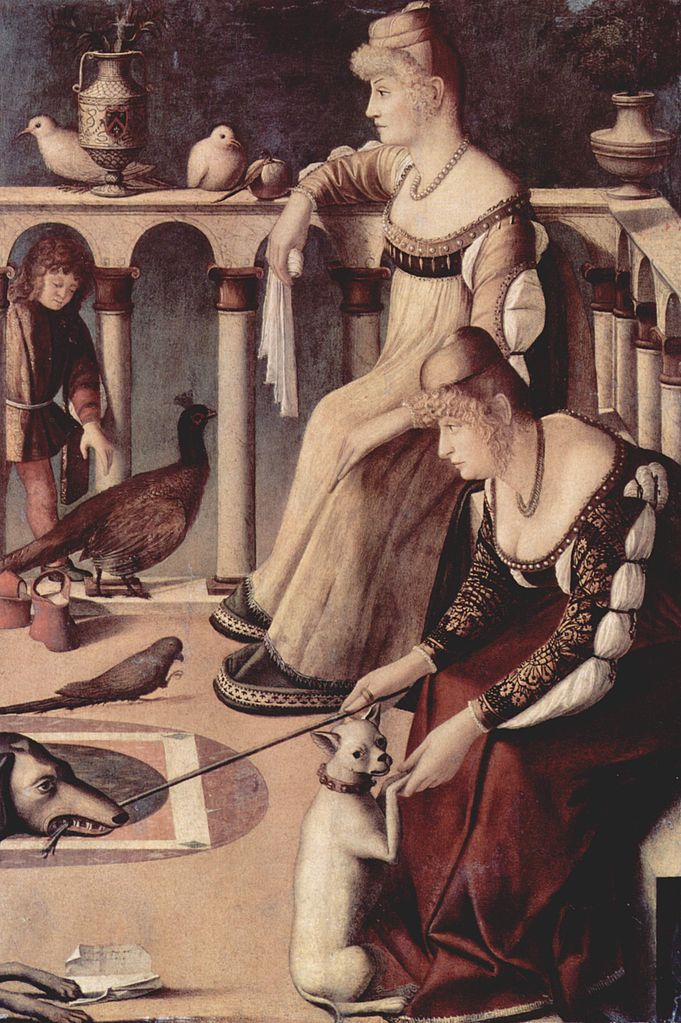
Vittore Carpaccio, Public domain, via Wikimedia Commons
Two Venetian Ladies was painted by Vittore Carpaccio, dating to approximately 1490. It is currently housed at Museo Correr.
This painting is believed to be a quarter of the original work. A second panel– that would have originally been above this panel– is called Hunting on the Lagoon and is in the Getty Museum. A third panel– believed to be part of this work– is also at the Getty and the fourth panel is believed to be lost at this time. The additional context added by the additional panels shifted the way this painting was viewed. It went from being viewed as two courtesans to two noble women on their own palazzo rooftop watching their husbands on the lagoon.
The noblewoman in the background of this painting wears the length of her hair taped in a coil to the top of her head. From the ears forward, her hair has been cut into bangs, curled, and fluffed forward.
Her large pearl necklace has a dangling pearl in the back for a closure.
Her body linen is not overly full and shows 2 different edge treatments– at the neck, it has been simply pleated and edged in a dark gold or black cord/stitching; at the wrists, we see a double-thickness, precisely pleated cuff.
The bodice neckline hovers just off the edge of the shoulder. This inhibits motion due to its placement on the upper arm; however, the inhibited motion is kept to a minimum by the narrowness of the shoulder strap. The band around the neck appears to be a straight of grain strip of fabric that has been precisely pleated and neatly stitched to follow the curves of the neckline. In the center of each panel created by the pleats, a pearl–likely glass– is mounted. Under each pearl, in suspended a gold or brass leaf shape. This follows all the way around the neckline other than skipping two pearls in front and in the back of the arm.
Over her dress is a finely pleated apron with needle lace edging at the bottom hem over a red or brown fabric binding the bottom edge. The points of the lace are weighted with alternating black and red beads.
Her sleeves are one-piece sleeves with curved edges opening over the body linen. The sleeves are a tube at the top and then open lower into curved edges adorned with a strip of another material — possibly the same as the main sleeve– on the bias– revealing the body linen. It is bound around the raw edges of the curved openings and then beaded with gold spangles as well as black and coppery-red beads. The same treatment is used at the cuff at the wrist openings.
The hem appears to be a band of slashed white material over a black band edged with needle lace on both sides of the band. The hem is obviously stiffened, as can be seen by the dress above the hem collapsing towards the ground above the edge of the stiffening. The adornment at the bottom edge is centered over the hem stiffening and does not touch the bottom edge of the hem.
The noblewoman in the foreground has a similar hairstyle to the noblewoman in the background– minus evidence of taping.
Her necklace appears to be interconnected metal rings, perhaps hammered silver. In addition to her necklace, the woman has a thick metal band ring on her right thumb.
Her body linen shows a similar but tidier knife pleat arrangement at the neck and possibly doubled box pleats at the fitted wrist. The body linen also shows underneath each arm and at the center front of the bodice, where the bodice is slashed to show the body linen.
Similar to the background noblewoman, the foreground figure has a neatly pleated and sewn straight of grain band that wraps around the curves of the neckline; however, her band is significantly narrower. Like the previous figure, there is a pearl–likely glass– at each panel of the pleated band. Her neckline is also cut further off the shoulder than the background noblewoman.
This figure’s sleeves appear to be a black and gold brocade, open all the way down the back with beaded ties.
The bottom edge of this noblewoman’s skirt has a black binding around the bottom with a gold band on top of that black binding. Her skirt is not as obviously stiffened as the background figure’s; however, the bound edge does provide some stiffening as can be seen right around the dog’s feet. This stiffening may have come from the gold band being pleated for more thickness.
